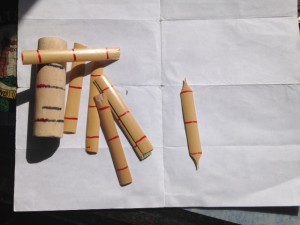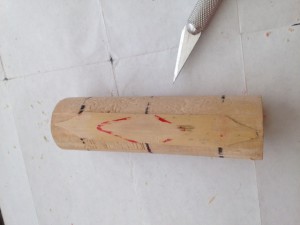by Bill Wakefield
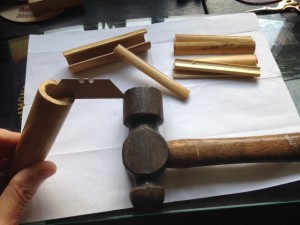
The first step in reed making is splitting cane cut to length with a stout blade and hammer to make the slips
For several summers in the 1970’s & 80’s I’d opportunity to study Highland piping with PM Evan MacRae, late of Ft William. I recall him exceptionally affable, of constant jocularity, and a fountain of stories about the army and India, where he’d served with the Queen’s Own Cameron Highlanders. I gathered that, at least in his day, pipe majors were expected to be reed makers and, at any rate, Evan MacRae was the first person I ever watched make a reed and, what’s more relevant for present purposes, he was the first to tell me that I ought to “have a go” at reed making. Although the suggestion appealed to me, such interest as I had wasn’t equal to my regrettable lack of workshop know-how; and with the difficulty of obtaining or making necessary equipment at a time when neither tools of the trade nor explanatory, instructional information were available, I didn’t pursue.
Much more recently, in 2011 at the excellent, residential course for Northumbrian Smallpipes held each October at Whitely Bay, Richard Evans, a well-know maker of smallpipes who is regularly on faculty at the course, suggested the same thing Evan MacRae had so many years ago, stating that players “really should” try to make reeds. This time I followed up a bit, resources being incomparably better these days, and a good friend who is very handy and lives not far away set me up with block & gouge and put me through the steps outlined in Colin Ross’ book, about which, more later.
Finally, after a year and a half of trying, not intensively at an average of perhaps several hours monthly, I seem to have got beyond the beginners stage during which, while learning the sequence of steps, I turned out a few acceptable reeds by chance. I’d like to think, too, that I’ve recently passed a longer and at times more frustrating, intermediate stage of practicing skills associated with the different steps, during which some acceptable reeds were produced amid many failures and botched attempts. But all the while I’ve learned from mistakes as well as by interrogating the experienced for explanations, tips, and insight.
Now that I can, with practiced understanding, produce an acceptable reed more often than not, I’m recalling the perspicacious if understated encouragement of Evan MacRae and Richard Evans with greater appreciation and, I think, better comprehension. What’s a bit ironic in this is the difficulty I’d have trying to explain why pipers “really should have a go” at reed making.
Understatement being best left to the British who are, after all, much better at it than us, I’d begin by mentioning a few obvious reasons for taking it up. The main spur for me was the thought that by learning to make reeds I’d gain understanding that would enable me to make appropriate adjustments the ones in my pipes, whether of my own manufacture or not. This sort understanding and resulting confidence actually accrues from the outset. In addition, one may aspire to such expertise as would enable one to control one’s sound — a prospect I find increasingly enticing, whether or not I ever achieve it. Naturally, less time waiting for replacement reeds in the post has its attractions and, of course, for anyone who could get to be both good and fast at it, I suppose the prospect of vast riches to be had selling them might prove a stimulating allurement.
Apart from these and no doubt other such practical considerations, I’d mention the sense of pleasant satisfaction that comes not only from making an acceptable reed for playing, but also from the process itself. A friend of mine, recently successful in competitions while playing one of his own reeds, mentioned feeling the former kind, while another friend alluded to the latter sort by comparing some reed making skills to those necessary in fly tying. He drew an interesting analogy by observing that “the fish teach you how to make the flies and, making them, you learn more about the fish.” This sort of insight and appreciation is impossible to quantify and express, really . One suspects it’s the reason understatement is employed as encouragement by those working “organically” in living piping traditions.
Not least among the many inducements to this rewarding craft is the sheer number of resources available to anyone interested in having a go. To begin with there is Colin Ross’ excellent Manual with detailed specifications and instructions: “Reedmaking for Northumbrian Smallpipes, Scottish Smallpipes, and Border Pipes,” available from the Northumbrian Pipers’ Society. Stephen Douglas has posted a series of videos showing Colin making reeds, which are a great inspiration and help. In its Members pages, the NPS website also has links to the videos. For those, like me, unable to make the few pieces of necessary equipment as described in Manual, John Ross, a silversmith in Devon, can provide superb hand made tools to the correct specifications, including block and hand-forged gouge.. For tube cane, both Ted Anderson at Piper’s Supply, in Northern California, and Joseph Sampson at Sampson Cane in Bakersfield are ready, reliable sources in the US, while Medir Cane seems to be the preferred European source.
Finally I think it very worthwhile pointing out that Chris Apps, an excellent, commercial reed maker, offers prepared slips and staples in order that pipers can learn reed making without initial investment in equipment, and this seems a great way to take initiation. I suspect there are many, many people who would shine at making reeds (and in less time than it took me just to get acceptable ones consistently) if they had slips and staples ready at hand, but who will not bother with it at all if they have to go to the trouble of getting equipment for splitting and gouging cane to make the slips. By the same token there may be others interested only in splitting and gouging! A little conversation on this topic between piping buddies and/or club members, along with pooling of resources might fruitfully result in more equipment circulating for use by sharing so that more slips could be made available and more pipers could try their hand at reed making — which they most emphatically should do.
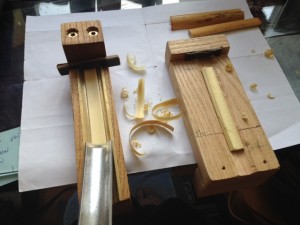
Gouging slips on the block. The homemade block on the right, while perfectly adequate, takes more practice to use because it lacks the brass guide rails visible on the other block. The gouge rests on these rails which are designed so that the slips are of uniform thickness every time with just a few strokes of the gouge.
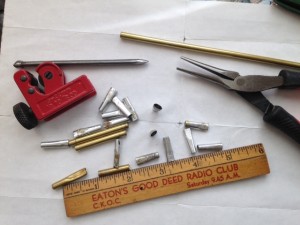
Brass and aluminum tubing and staples made from it. Notice two staples stood on end showing the shaped aperture.
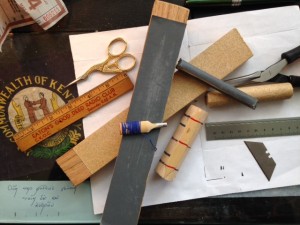
Staple inserted between the blades of the folded slip — usually held in place by glue before binding
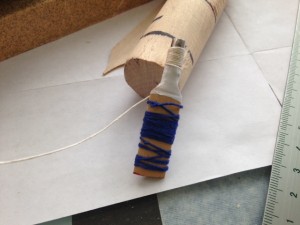
The plumbers tape ensures airtightness before binding with thread for strength. After this comes the long process of alternately sanding and scraping the blades to nicely tapered shape, adding the wire bridle and further scraping until the reed ‘craws’ in about C#
Bill Wakefield Lives in San Francisco and has been piping for more than 40 years. Having trained on Highland bagpipes from an early age, he took up Northumbrian and Scottish smallpipes in his 20’s on becoming an apartment dweller and currently plays and maintains several sets of pipes as so many vestal flames.

